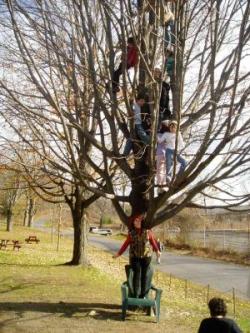
The B-Mitzvah (R)evolution
Re-infusing meaning, relevance and spirituality into Bar Mitzvah and Bat Mitzvah is what families request, when given the opportunity for input. I did my doctorate on this topic and that was the overwhelming finding. Families report needing help to overcome the often toxic social and educational norms that have arisen regarding the B'nei Mitzvah process and to revision and adopt healthy new models.
Each generation interprets and evolves the wisdom and practices that nourish and guide the life of our people. Indeed, we have a practice called hiddur mitzvah, “the beautification” of a mitzvah. It is in itself a mitzvah to improve, advance, glorify, decorate, and expand the meaning, practice, and quality of the many mitzvot. So our tradition encourages and supports each of us in the quest to reflect the unique content of our individual lives during Bar Mitzvah and Bat Mitzvah rituals and celebration.
Perhaps you will be surprised to learn that the Torah never mentions Bar Mitzvah. Keep in mind that the story of Abraham probably dates around 1200–1300 B.C.E. The term Bar Mitzvah is first documented in the eighth century C.E. Evidence also reveals a form of Bat Mitzvah was offered in Germany beginning in 1814, then in the Balkans and Italy by the mid-1800s, in Cairo by 1907, and in the United States in 1921. A number of countries have just begun to understand the importance of celebrating the commitment of a girl as well as of a boy; the Jewish community in Romania has only adopted Bat Mitzvah upon entering the 21st century.
It seems that in its early stages of development, the adolescent rite of passage ritual was not done by the person transitioning into young adulthood, but rather by his parents! Having labored to raise a committed and knowledgeable son, a parental ritual emerged of publicly reciting a blessing for having become free of the responsibility to supervise his relationship to continued studied of Torah and mitzvah, and living a mitzvah-centered life. Some parents still choose to offer this blessing: Barukh she-petarani me-onsho shel zeh, “Blessed is the one who has exempted me from the punishment of this one." Note: Today’s denominational prayer books offer a range of alternative blessings which reflect changing perspectives on the meaning of B-mitzvah. Many parents and students also choose to add the blessing known as the Shehecheyanu, which expresses gratitude to the Source for “giving us life, sustaining us and bringing us to this season.”
Many of the rituals and requirements associated with Bar Mitzvah and Bat Mitzvah today would be quite surprising to those who first introduced the concept. Torah leyning (chanting) was not part of B'nei Mitzvah originally at all, the first shift seems to have been from the male parent blessing upon release from responsibility for the young person's Jewish practice, to the young adult coming up to say a blessing their own aliyah and their family providing a "seudah shel mitzvah" a meal in honor of the young adult's token demonstration of one mitzvah (blessing for the aliyah) to symbolize being
With the professionalization of the rabbinate, the shift to a majority of B'nei Mitzvah initiates offering Torah interpretations began, some say not until the late nineteenth century. What was the rabbi to offer that would be "value added" for the education of a youth entering Jewish young adulthood? The ability to explicate upon the Torah seemed a good rabbinic skill for transmission. Many rabbis were relieved when the full-time cantorate became a profession, for becoming a rabbi typically has meant loving text study, not necessarily being good at working with adolescents. The students were then primarily sent to the cantor, and what do cantors do best? Lead services and chant Torah. So they began to transmit their primary skills to our youth.
Problem is, the main principle of Jewish young adulthood is knowledge of the mitzvot, and cultivation of the ability to live a mitzvah-centered, rather than a self-centered life. Not a self-less life, rather cultivation of the self of the youth so that mitzvot from self-care, awe and love of Creation, to care for all sentient life can be expressed with depth and sincerely. Substituting synagogue skills for creating a meaningful Jewish life that touches and involves the youth in spirited Jewish living and support isn't the direction we can take anymore, IMHO. This only sounds radical because of the 20th Century shifts in B'nei Mitzvah, most tribes know that shaping the possible human is what adolescent rites of passage are all about!
There are at least 52 mitzvot our youth and families will delight in knowing and living and there are many roles to take on that give each person a meaningful seat at the table of Jewish life. A bunch of friends and colleagues pointed out to me that the program title I often use "" has just appeared, in part, in a press release for a new Union for Reform Judaism initiative "URJ Campaign for Youth Engagement Launches B'nai Mitzvah Revolution and Revamps Conference for Youth Practitioners." Nothing makes me happier than when something I'm working on gets picked up on a large scan and folks run with it, or perhaps it arose with them suis generis because this is sure need folks! I couldn't find anything meaningful in the press release beyond the title and an apparent awareness of need for change, may their process be blessed - happy to help! By the way, in addition to all the articles on the subject under bar/bat mitzvah on this website, I wrote a book on the principles and methods we've developed here at Reclaiming Judaism, and added new methods and material in my recent book Living Jewish Life Cycle: How to Create Meaningful Rites of Passage at Every Stage of Life (Jewish Lights).
Photo: Students on a B Mitzvah! Family Adventure Retreat with Rabbi Milgram climb a tree to show her how they are part of the Jewish Tree of Life.